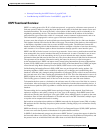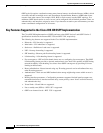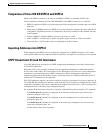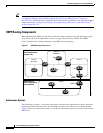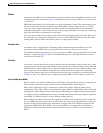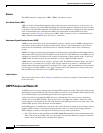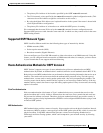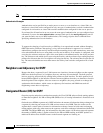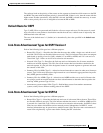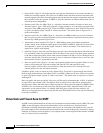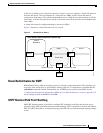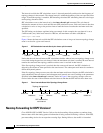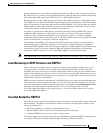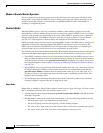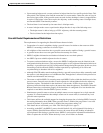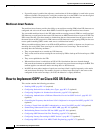
Implementing OSPF on Cisco IOS XR Software
Information About Implementing OSPF on Cisco IOS XR Software
RC-137
Cisco IOS XR Routing Configuration Guide
The software looks at the priority of the routers on the segment to determine which routers are the DR
and BDR. The router with the highest priority is elected the DR. If there is a tie, then the router with the
higher router ID takes precedence. After the DR is elected, the BDR is elected the same way. A router
with a router priority set to zero is ineligible to become the DR or BDR.
Default Route for OSPF
Type 5 (ASE) LSAs are generated and flooded to all areas except stub areas. For the routers in a stub
area to be able to route packets to destinations outside the stub area, a default route is injected by the
ABR attached to the stub area.
The cost of the default route is 1 (default) or is determined by the value specified in the default-cost
command.
Link-State Advertisement Types for OSPF Version 2
Each of the following LSA types has a different purpose:
• Router LSA (Type 1)—Describes the links that the router has within a single area, and the cost of
each link. These LSAs are flooded within an area only. The LSA indicates if the router can compute
paths based on quality of service (QoS), whether it is an ABR or ASBR, and if it is one end of a
virtual link. Type 1 LSAs are also used to advertise stub networks.
• Network LSA (Type 2)—Describes the link state and cost information for all routers attached a
multiaccess network segment. This LSA lists all the routers that have interfaces attached to the
network segment. It is the job of the designated router of a network segment to generate and track
the contents of this LSA.
• Summary LSA for ABRs (Type 3)—Advertises internal networks to routers in other areas (interarea
routes). Type 3 LSAs may represent a single network or a set of networks aggregated into one prefix.
Only ABRs generate summary LSAs.
• Summary LSA for ASBRs (Type 4)—Advertises and ASBR and the cost to reach it. Routers that
are trying to reach an external network use these advertisements to determine the best path to the
next hop. ABRs generate Type 4 LSAs.
• Autonomous system external LSA (Type 5)—Redistributes routes from another autonomous
system, usually from a different routing protocol into OSPF.
Link-State Advertisement Types for OSPFv3
Each of the following LSA types has a different purpose:
• Router LSA (Type 1)—Describes the link state and costs of a the router link to the area. These LSAs
are flooded within an area only. The LSA indicates whether the router is an ABR or ASBR and if it
is one end of a virtual link. Type 1 LSAs are also used to advertise stub networks. In OSPFv3, these
LSAs have no address information and are network protocol independent. In OSPFv3, router
interface information may be spread across multiple router LSAs. Receivers must concatenate all
router LSAs originated by a given router before running the SPF calculation.



